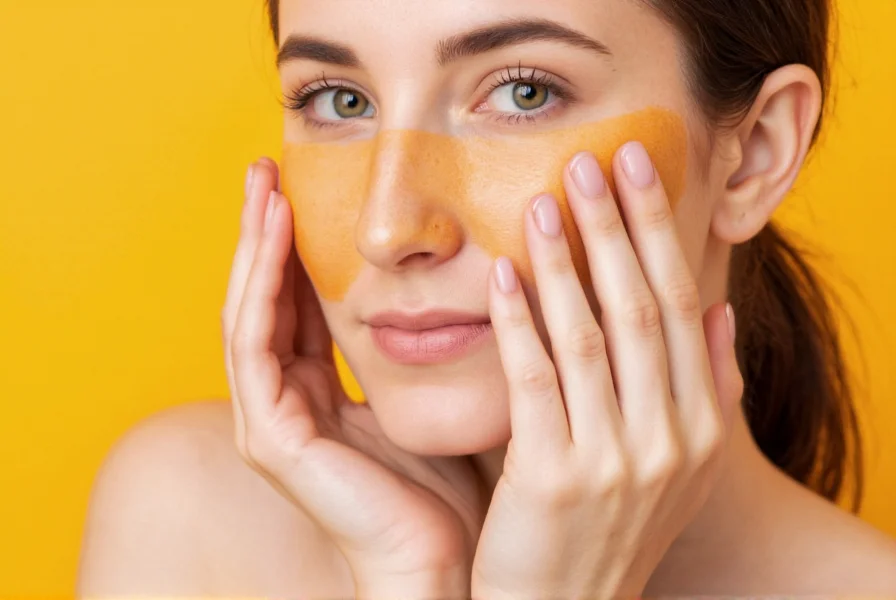For centuries, turmeric has been used in traditional Ayurvedic and Chinese medicine for various skin conditions. Modern research suggests its active compound, curcumin, may help address hyperpigmentation through multiple mechanisms. This comprehensive guide examines what current science says about using turmeric for dark spots, how to use it safely, and what results you can realistically expect.
The Science Behind Turmeric and Skin Pigmentation
Turmeric (Curcuma longa) contains curcumin, which constitutes about 2-8% of the rhizome. Curcumin's potential effects on dark spots stem from several biological properties:
| Mechanism | How It Works | Relevance to Dark Spots |
|---|---|---|
| Tyrosinase inhibition | Blocks the enzyme responsible for melanin production | May reduce excess pigment formation |
| Anti-inflammatory | Reduces inflammation that triggers post-inflammatory hyperpigmentation | Helps prevent dark spots after skin injury |
| Antioxidant | Neutralizes free radicals that contribute to skin damage | May prevent UV-induced pigmentation |
| Cell signaling modulation | Affects pathways involved in melanocyte activity | Potentially regulates melanin production |
What Does the Research Say About Turmeric for Dark Spots?
While traditional use suggests benefits, scientific evidence specifically for turmeric's effectiveness on dark spots remains limited but promising. A 2019 study published in Phytotherapy Research found that a topical formulation containing 1% curcumin significantly reduced melasma severity after eight weeks of use. However, the study had a small sample size (30 participants) and lacked a control group.
Another clinical trial examining a turmeric-based cream for post-inflammatory hyperpigmentation showed modest improvement after 4 weeks, but results were less effective than standard hydroquinone treatments. The main challenges researchers face include:
- Curcumin's poor skin absorption and stability
- Limited large-scale human studies specifically on dark spots
- Most research focuses on oral supplementation rather than topical application
- Variability in turmeric formulations used across studies

How to Use Turmeric for Dark Spots: Practical Application
If you're considering turmeric for hyperpigmentation, proper application is crucial for both effectiveness and safety. Here's how to incorporate it into your skincare routine:
Effective Turmeric Formulations
For does turmeric remove dark spots to be answered positively, consistency and proper formulation matter. The most effective DIY turmeric preparations include:
Turmeric and Honey Mask
- Mix 1 teaspoon turmeric powder with 2 teaspoons raw honey
- Add 1 teaspoon plain yogurt for sensitive skin
- Apply to clean skin, leave for 15-20 minutes
- Rinse with lukewarm water
- Use 2-3 times weekly for 8-12 weeks
Turmeric Spot Treatment
- Combine 1/4 teaspoon turmeric with 1 teaspoon aloe vera gel
- Add 2-3 drops of lemon juice (use cautiously as it may cause sensitivity)
- Apply directly to dark spots only
- Leave on for 10-15 minutes before rinsing
- Follow with moisturizer
Safety Considerations and Potential Side Effects
When exploring how to use turmeric for hyperpigmentation, safety should be your priority. Common issues include:
- Temporary skin staining: Turmeric can temporarily yellow light skin tones. Using lower concentrations (1-2%) and adding milk or yogurt can minimize this.
- Staining of fabrics: Wear old clothing during application and rinse thoroughly.
- Skin irritation: Perform a patch test 24 hours before full application, especially if you have sensitive skin.
- Photosensitivity: Some users report increased sun sensitivity, so always use sunscreen during treatment.
Avoid using turmeric if you have known allergies to ginger or other plants in the Zingiberaceae family. Discontinue use immediately if you experience redness, itching, or swelling.
Realistic Expectations: How Long Until You See Results?
Understanding is turmeric effective for melasma requires patience. Most users report:
- Noticeable changes typically appear after 4-8 weeks of consistent use
- Maximum results usually seen around 12 weeks
- Improvement is generally modest (20-30% lightening) compared to clinical treatments
- Results vary significantly based on skin type and cause of hyperpigmentation
Turmeric works best for post-inflammatory hyperpigmentation rather than deeper melasma or sun damage. For scientific evidence turmeric for skin discoloration, remember that individual results vary considerably.
Turmeric vs. Conventional Dark Spot Treatments
When considering turmeric vs hydroquinone for dark spots, it's important to understand the differences:
- Natural approach: Turmeric offers a gentler, natural alternative with fewer side effects than hydroquinone
- Effectiveness: Clinical treatments typically produce faster, more dramatic results
- Safety profile: Turmeric has fewer long-term safety concerns than hydroquinone
- Cost: Turmeric is significantly more affordable than prescription treatments
For stubborn dark spots, consider combining turmeric with other natural ingredients like licorice root extract or niacinamide, which have stronger evidence for hyperpigmentation treatment.
When to Consult a Dermatologist
While natural remedies for dark spots with turmeric can be helpful, see a dermatologist if:
- Your dark spots suddenly change in appearance
- You experience no improvement after 12 weeks of consistent use
- You have sensitive skin or a history of allergic reactions
- Your dark spots are accompanied by other symptoms
- You're unsure about the cause of your hyperpigmentation
A dermatologist can help determine if your dark spots require medical treatment rather than home remedies. Professional treatments like chemical peels, laser therapy, or prescription creams may be necessary for significant improvement.
Conclusion: Setting Realistic Expectations
Turmeric shows promise as a natural approach for reducing dark spots, but it's not a miracle cure. The evidence supporting turmeric and curcumin for skin lightening suggests modest benefits with consistent use over several months. For best results, combine turmeric treatments with sun protection, proper skincare, and realistic expectations about what natural remedies can achieve.
How long does it take for turmeric to lighten dark spots?
Most users notice modest improvements after 4-8 weeks of consistent use, with maximum results typically visible around 12 weeks. Individual results vary based on skin type, the cause of hyperpigmentation, and consistency of application.
Can turmeric permanently remove dark spots?
Turmeric cannot permanently remove dark spots. Like most hyperpigmentation treatments, results require maintenance. Continued sun protection is essential, as UV exposure can cause dark spots to return regardless of treatment method.
Does turmeric work better than lemon juice for dark spots?
Yes, turmeric generally works better and is safer than lemon juice. While both have some skin-brightening properties, lemon juice is highly acidic and can damage the skin barrier, increase photosensitivity, and potentially worsen hyperpigmentation. Turmeric offers anti-inflammatory benefits without the same risks.
Can I leave turmeric on my face overnight?
It's not recommended to leave turmeric on your face overnight due to the risk of significant yellow staining on skin and bedding. Most effective applications suggest 15-20 minutes for masks or 10-15 minutes for spot treatments before rinsing off.
What's the best way to prevent turmeric from staining my skin?
To minimize staining, use lower concentrations (1-2% turmeric), mix with milk or yogurt, apply for shorter durations (10-15 minutes), and rinse thoroughly with warm water. Adding a small amount of oil to your rinse water can help remove any residual color.











 浙公网安备
33010002000092号
浙公网安备
33010002000092号 浙B2-20120091-4
浙B2-20120091-4